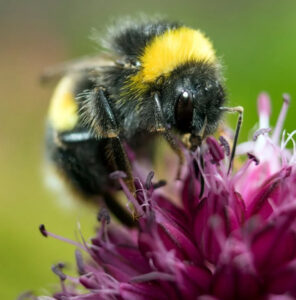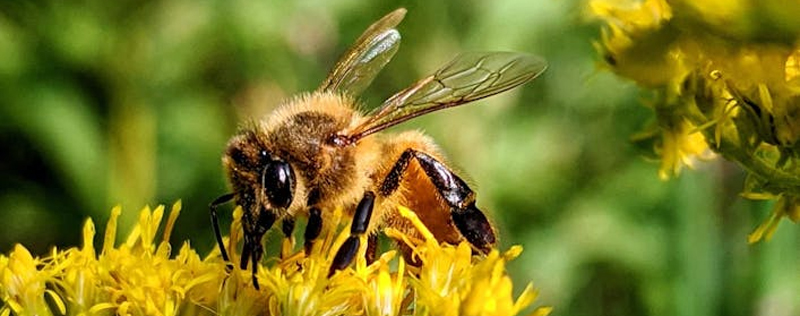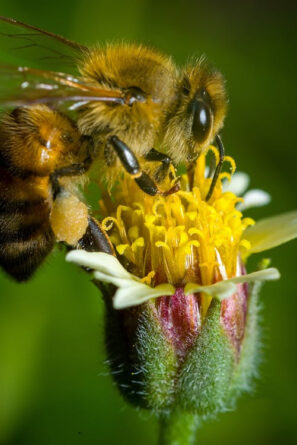WORLD BEE DAY: HOW TO HELP BEES
Bees play a crucial role in our ecosystem and food supply. They are vital pollinators, responsible for pollinating around 75% of the world’s flowering plants, including approximately 35% of global food crops. Without bees, many fruits, vegetables, nuts, and seeds would struggle to reproduce, leading to decreased biodiversity and potential food shortages. Furthermore, bees contribute to the health of plants that provide habitats for other wildlife, maintaining the balance of our ecosystems.
However, bee populations are declining due to factors such as habitat loss, pesticide use, climate change, and diseases. To support these essential pollinators, we can take actionable steps in our own gardens and communities. Here are a few ideas including Bee Gardens, Planting Trees, and Bee Baths.
Creating Bee Gardens
 Why It’s Important:
Why It’s Important:
Bee gardens provide bees with a diverse array of nectar and pollen sources, crucial for their nutrition and health. These gardens also create safe habitats where bees can thrive without the threat of pesticides and habitat destruction.
How to Create a Bee Garden:
1. Choose a Variety of Plants: Plant a wide range of flowers that bloom at different times throughout the year to ensure a continuous food source for bees. Include native plants, as they are best suited to the local environment and are more beneficial to local bee species.
2. Opt for Single-Bloom Flowers: Single-bloom flowers have more accessible pollen and nectar compared to double-bloom varieties. Examples include sunflowers, marigolds, and cosmos.
3. Avoid Pesticides: Use organic or natural methods to manage pests. Pesticides can be toxic to bees and other beneficial insects.
4. Create Clusters: Plant flowers in clusters rather than singly. Bees are more attracted to large groups of flowers, making it easier for them to forage efficiently.
5. Include Bee-Friendly Herbs: Herbs like lavender, sage, and thyme are not only great for cooking but also attract bees.

Planting Trees for Bees
Why It’s Important:
Trees provide essential habitats and food for bees. They offer pollen, nectar, and, in some cases, resin used by certain bee species to build nests. Trees also contribute to a stable environment by regulating temperature and providing shelter.

How to Plant Trees for Bees:
1. Select Bee-Friendly Trees: Choose trees known for their bee-friendly flowers, such as apple, cherry, willow, and linden. These trees provide ample nectar and pollen.
2. Consider Bloom Times: Just like with flowers, it’s beneficial to select trees that bloom at different times to provide a steady food source throughout the year.
3. Plant Strategically: Plant trees in sunny locations with good soil drainage. Ensure they have enough space to grow and spread their branches.
4. Maintain the Trees: Regularly water young trees, mulch to retain soil moisture, and prune to remove dead or diseased branches.
Creating a Bee Bath
Why It’s Important:
Just like any other creature, bees need water to survive. A bee bath provides a safe place for bees to drink and collect water for their hive.
How to Create a Bee Bath:
1. Select a Shallow Container: Use a shallow dish or bird bath that is no more than a couple of inches deep. Bees can drown in deeper water.
2. Add Landing Pads: Place small stones, marbles, or pieces of wood in the water. These serve as landing pads where bees can safely land and drink without the risk of drowning.
3. Change the Water Regularly: Ensure the water is clean by changing it every few days. This prevents stagnation and mosquito breeding.
4. Position in a Safe Place: Place the bee bath in a sunny, sheltered spot near your bee garden or flowering plants. This makes it convenient for bees to find and use.
Additional Tips to Support Bee Populations
Provide Shelter: Leave some areas of your garden undisturbed, with piles of wood, leaves, or dry grass where bees can nest.
Educate Others: Spread awareness about the importance of bees and how others can help support them.
Support Organic Farms: Buy organic produce to encourage farming practices that are less harmful to bees.
By taking these steps, you can create a welcoming environment for bees, helping to sustain their populations and the critical ecological services they provide. Every small action counts in the effort to protect these indispensable pollinators.
 ABOUT THE AUTHOR
ABOUT THE AUTHOR
Chantal Cooke is an award-winning journalist and broadcaster and co-founder of PASSION for the PLANET.
Facebook @chantalcooke,
X/Twitter @chantalcooke
Instagram @Chantaldcooke

